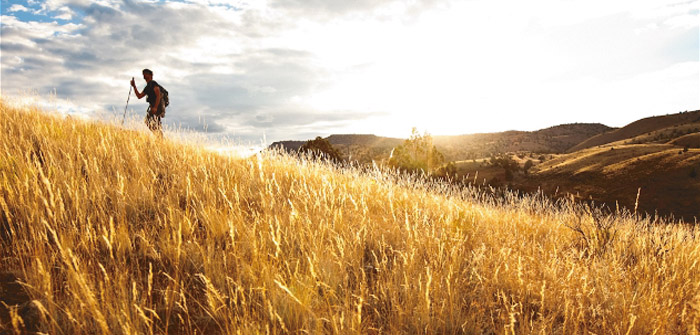Ask anyone who has moved to Central Oregon recently why they chose the high desert and most will include recreational opportunities, natural beauty and quality of life. What all of these things have in common is our close proximity to an incredible diversity of wilderness opportunities. Whether here for the mountain biking, skiing or endless miles of trails…or the stunning sky line, clean water and malty beverages, Central Oregonians (and numerous visitors) think the high desert is an excellent place to live, work and play.
For a state that is renowned for its natural beauty and open spaces, it may surprise some that only four percent of Oregon is designated as wilderness, a figure that is far below our neighboring states of Washington, California, Idaho and Nevada. In fact, nearly half the state is high desert yet of the 47 wilderness areas throughout Oregon, only three are in the high desert, meaning there are great tracts of land that could be protected.
As Brent Fenty, executive director for the Oregon Natural Desert Association (ONDA) explained, more wilderness can lead to more economic benefits for the surrounding areas.
“We are seeing communities more and more that almost exist as a function of their relationship to public lands and use of those public lands,” Fenty explained. “And recent studies have come out that have done a good job of isolating what exactly that economic contribution could be and how it helps communities thrive.”
From Headwater Economics, an independent, nonprofit research group, to ECONorthwest, the largest economic consulting firm in the Pacific Northwest, studies show the economic impact of wilderness areas can range from recreation assets, an increased quality of life factor that can attract new residents and businesses, increased property values and other off-site benefits like watershed protection and fish/wildlife habitat protection.
According to Wilderness.net, a collaborative partnership between the College of Forestry and Conservation’s Wilderness Institute at The University of Montana, the Arthur Carhart National Wilderness Training Center and the Aldo Leopold Wilderness Research Institute, “Recent studies of western counties and states have shown that population, income and employment growth increased as the percentage of wilderness increased, and the West’s popular national parks, monuments, wilderness areas and other public lands offer its growing high-tech and services industries a competitive advantage…Proximity to wilderness is therefore an important reason why, in another study, 45 percent of long-time residents and 60 percent of recent migrants lived in or moved to counties containing wilderness.” (See http://www.wilderness.net/NWPS/valuesEconomical for a list of sources)
“Here in Bend is a perfect example,” Fenty explained. “When the Badlands Wilderness area was being discussed a lot of the business community came on board and supported the campaign because they recognize their ability to recruit and maintain employees has a lot to do with the surrounding recreational assets, and the Badlands is part of that. People want to go hiking in the Three Sisters Wilderness in the summer and hiking in the Badlands in the winter. The same thing can be said of biking and all other forms of recreation.”
The high desert is poised to become even more attractive as several potential wilderness areas wait for approval from Congress including the Sutton Mountain Wilderness Proposal, located near Mitchell and the Painted Hills; the Hidden Springs Proposed Wilderness, representing the largest swath of wild desert in Central Oregon found near the South Fork of the Crooked River; the Whychus-Deschutes Proposed Wilderness, an area which provides prime spawning habitat for salmon and steelhead and the Cathedral Rock and Horse Heaven Proposed Wilderness, an area along the John Day River home to 36 sensitive plant, fish and animal species.
“Clearly Wheeler County sees [the proposed Sutton Mountain Wilderness]as something that compliments visitation that is already occurring and are looking at how they can keep those people longer in the community, [and figure out]how they can contribute to the economy in a more meaningful way,” Fenty commented.
“This proposal really is in the best interests of local residents,” Wheeler County Judge Chris Perry told ONDA. “It will create economic opportunities through tourism and visitation to the new wilderness…The majority of area residents I’ve heard from are in favor of this plan, and they agree that it will breathe new life into a tired horse.”
Fenty explained that even in communities that were initially resistant to the idea of more federally protected land have come to see the economic benefits it can bring to an area. “One that comes to mind is the Grand Escalante National Monument in Utah,” he said. “It was extremely unpopular at a local level, and in 1996 it was designated in a very conservative county that thought it would ultimately kill the local economy. It’s done the opposite…you can see how those communities have slowly embraced the change and it’s really because the historic uses haven’t been swept away. They now coexist with this conservation designation that has brought a lot of people to explore and enjoy the very remote and wild natural treasure.
“Clearly there is an economic benefit [to wilderness]but it has to be owned by the community and the community needs to decide how it wants to emphasis the potential economic values of those areas.”
How can Central Oregonians take ownership of these proposed wilderness areas in our back yard? One of the simplest ways is head outside. Better yet? Take a friend or neighbor with you – perhaps someone who isn’t as familiar with the land – and hike; watch an osprey catch dinner or an antelope prance across fields of sage.
Connect with the landscape and reach out to your local legislators. With many of these proposed wilderness areas stuck in Congress, those decision makers need to hear from you: tell your stories and share your passion for what makes Central Oregon great, if not for us, than as a legacy for Central Oregonians to come.
For more information about Oregon’s wilderness areas and economic benefits visit www.onda.org, www.oregonwild.org or www.wilderness.net





